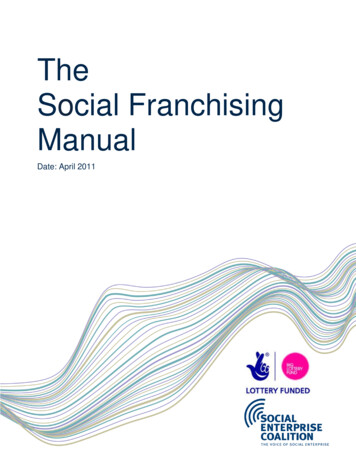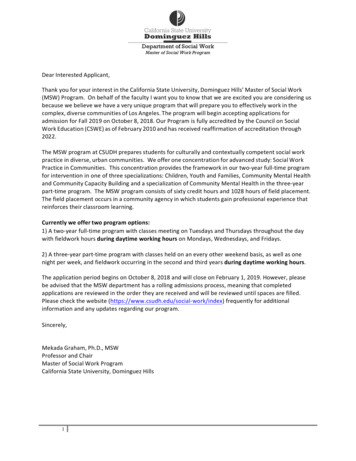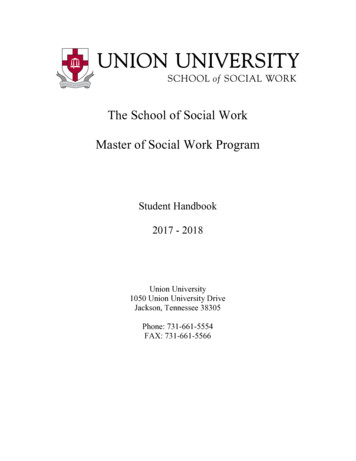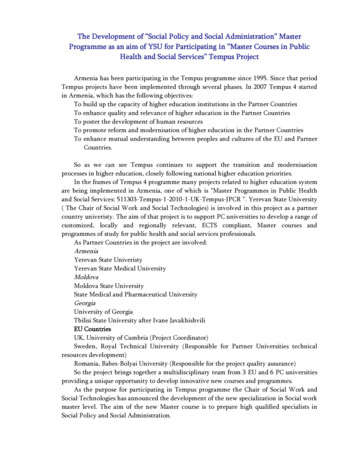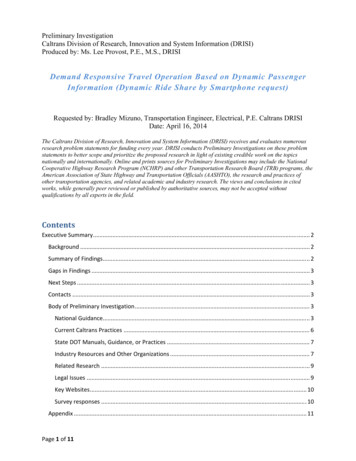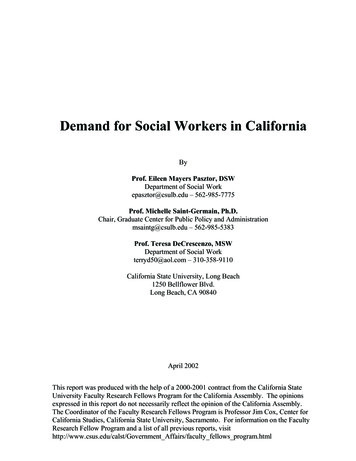
Transcription
Demand for Social Workers in CaliforniaByProf. Eileen Mayers Pasztor, DSWDepartment of Social Workepasztor@csulb.edu – 562-985-7775Prof. Michelle Saint-Germain, Ph.D.Chair, Graduate Center for Public Policy and Administrationmsaintg@csulb.edu – 562-985-5383Prof. Teresa DeCrescenzo, MSWDepartment of Social Workterryd50@aol.com – 310-358-9110California State University, Long Beach1250 Bellflower Blvd.Long Beach, CA 90840April 2002This report was produced with the help of a 2000-2001 contract from the California StateUniversity Faculty Research Fellows Program for the California Assembly. The opinionsexpressed in this report do not necessarily reflect the opinion of the California Assembly.The Coordinator of the Faculty Research Fellows Program is Professor Jim Cox, Center forCalifornia Studies, California State University, Sacramento. For information on the FacultyResearch Fellow Program and a list of all previous reports, visithttp://www.csus.edu/calst/Government Affairs/faculty fellows program.html
TABLE OF CONTENTSLIST OF TABLES AND FIGURES.vACKNOWLEDGEMENTS .viEXECUTIVE SUMMARY .1I.INTRODUCTIONA. Purpose of the Study .3B. Rationale for the Study .3II.METHODOLOGYA. Literature Review .5B. Statute Review .5C. Operational Definition of “Social Worker” .5D. Numerical Estimates of Need .5E. Education and/or Training Requirements .7III. FINDINGSA. Literature Review .9B. Statute Review .13C. Operational Definitions.14D. Numerical Estimates of Need .16E. Education and/or Training Requirements .31F. Conclusions.36IV. RECOMMENDATIONSA. Creating a Positive Public Image for Social Workers .40B. Enhancing Career Opportunities.41C. Improving Working Conditions.42D. Providing Compensation and Benefits Commensurate with the Work .43E. Creating Diverse Opportunities for Social Work Education .44F. Reclassifying and Renaming Social Work Positions.46G. Crafting Public Policy.47APPENDIX A. - Request for Information Distributed to Jurisdictions .49APPENDIX B. - Geographical Location of Reporting Jurisdictions .52APPENDIX C. - Population of Reporting Jurisdictions.54APPENDIX D. - Statutes and Codes .56
APPENDIX E. - Factors Affecting the Social Worker Shortage: Historical Perspective andStudies.68BIBLIOGRAPHY.86
LIST OF TABLES AND FIGURESTable 1.Nationwide Vacancy Rates for Social Workers .10Table 2.Demand for Child Welfare Social Workers in 39 Counties .23Table 3.Demand for Child Welfare Social Workers in 58 Counties .25Table 4.Demand for All Social Workers in 39 Counties .27Table 5.Demand for All Social Workers in 58 Counties .28Table 6.Distribution of Social Workers by Position.31Figure 1. Educational Requirements for Case Workers Using Merit Systems Service (MSS)Definitions .32v
ACKNOWLEDGEMENTSMany individuals and organizations provided essential support for this endeavor.First, we acknowledge the concern and responsibility of the California Assembly HumanServices Committee, under the leadership of Assemblywoman Dion Aroner (D-Berkeley),for addressing the issue of the shortage of social workers through roundtables, hearings, andresearch. We appreciate the diligent work of Kirsten Deichert, MSW, Senior Consultant forthe Assembly Human Services Committee.At the California Research Fellows Program at the Center for California Studies, CaliforniaState University, Sacramento, we thank the Fellows Program director, James Cox, Ph. D. forhis technical assistance and timely responses. We also appreciate the efforts of ShelaSchubin at the Center who graciously provided explanations to help us with all thepaperwork.We appreciate the cooperation of the California Welfare Directors Association and especiallythe support of John Cullen, Vice President at Large, Contra Costa, and Frank Mecca,Executive Director, for helping us contact county agencies. Our findings would not bepossible without the willingness and ability of the responding agencies, and we especiallythank the directors and staff who thoughtfully and kindly attended to our persistent requestsfor immediate information.We thank David Kopperud with the California Department of Education, Safe Schools &Violence Prevention Office for his timely response to our request for information regardingschool social workers.We thank the staff of GLASS (Gay and Lesbian Adolescent Social Services) in Los Angelesfor their dedication to this project. Special recognition is due to Khush Cooper, MSW (Ph.D.candidate, 2003), a social work supervisor at GLASS, for her invaluable assistance with theliterature review. Special thanks also to Frances Hammond, BSW who organized the mailingof the survey instruments to every county in the state, as well as personally contacted 30counties with professionalism.At the Graduate Center for Public Policy and Administration at California State University,Long Beach we thank Rebecca Bennett (MPA candidate, September 2002) for diligentlyconducting our review of the statutes and codes.At California State University, Long Beach, Department of Social Work we have manysupportive colleagues to acknowledge. First, we thank Dr. John Oliver, Director, for hiscommitment to this initiative and for arranging an immediate connection between theDepartment of Social Work and the Graduate Center for Public Policy and Administration.We thank Prof. Julie O’Donnell, Ph.D. for guiding us to information about school socialworkers, and we thank Prof. Barbara Cohen, MSW, Director of Field Instruction, who helpedus obtain information about social workers at Regional Centers. Special thanks to Prof.Tessie Cleveland, DSW, former director of King/Drew Medical Center Department of Socialvi
Services, for her perspectives. We appreciate James Ferreira, MSW, Director, Child WelfareTraining Center, for facilitating our paperwork through the University.Special thanks to Akilah Runnels, (MSW candidate, May 2002) for organizing the time towork on our project, for her professional and personable contacts with 28 counties in theState, and for her technical assistance in producing our written materials.We appreciate the work of Aura Lair (MSW candidate, May 2002) who also assisted withthe literature review as part of a project for her child welfare class with Prof. DeCrescenzo.The combined efforts and commitment of these individuals enabled us to complete thisproject within the limited time and budget allowed.vii
EXECUTIVE SUMMARYPurposeThis project was commissioned by the California Assembly through the California StateUniversity Faculty Research Fellows Program to:(1) review the literature describing the need for increased numbers of social workers;(2) review California statutes requiring social workers to provide state-supported services;(3) develop a clear operational definition of “social worker;”(4) develop a systematic description of the statewide demand for social workers; and(5) describe the education and/or training level required of social workers to fill identifiedneeds.MethodologyNumerical estimates of need for social workers in California were developed using datacollected from county social service agencies, which included:(1) the total number of social worker positions in the agency;(2) the distribution of these positions across programs, e.g. child welfare, aging, mentalhealth, disabilities;(3) the educational requirements for these positions;(4) the number of current positions filled by waivers of the educational requirements;(5) the number of current vacant positions;(6) increases or decreases in the number of these positions expected in the next few years;and(7) the jurisdiction’s operational definition of "social worker."Limitations include the short time frame for the research and the collection of data during theholiday period of November 2001 to January 2002; as well as the absence of data on the need forsocial workers in the private and/or non-profit sectors.Findings1) The literature points to social work as one of the faster growing sectors of employment,and documents the increasing need for social workers in general.2) There are a few California statutes requiring social workers to provide state-supportedservices, most notably in child welfare services; there are also some regulationsconcerning the training that staff must have to perform certain duties.3) There is wide variation among counties on the definition of what constitutes a “socialworker” position, but the critical skill is the ability to assess a situation to determinewhether there is a need for services and, if so, which ones.4) Numerical estimates of need were calculated based on data from two-thirds of thecounties, covering 85% of the population of California. Currently there are an estimated12,221 social workers positions at the county level in all 58 counties in California. Thecurrent vacancy rate is estimated at 9.5% (which is very close to national figures), whichtranslates to a current need for 1,171.5 new social workers (although needs vary widelybetween urban and rural counties). If turnover rates are taken into account, this becomesan annual rather than a one-time need. If, in addition, Assembly Bill 364 passes, mostcounties would double the number of child welfare workers within five years. This1
would increase the need for new social workers from a low of 9,248.5 (with zeroturnover) to a high of 22,196.4 (with 20% per year turnover) over the next five years. Ifall types of social workers are considered, the need for new social workers over the nextfive years could climb as high as 25,279.2 (with 20% turnover), even if no new positionsare created other than the ones in conformance with AB 364.5) The education and training requirements for social worker positions vary widely.a. At the entry level (10% of all jobs), even through they carry the job title of“social worker,” these positions do not require college-level coursework in socialwork. Educational requirements can be filled by training programs.b. At the advanced entry level (one-third of all jobs), most positions do not require acollege degree in social work. Educational needs can be filled by coursework at acommunity college or unaccredited social work program.c. At the lead social worker level (half of all jobs), undergraduate courses in socialwork are generally required. Any increase in the number of these positions willrequire an increase in the number of persons enrolled in accredited BA programsof social work in California each year.d. At the supervisory level (15% of all jobs), a masters degree in social work isusually required. Any increase in the number of these positions will require anincrease in the number of persons enrolled in accredited MSW programs inCalifornia each year.ConclusionsThe level of demand for social workers will continue to escalate across the program areasof child welfare, disabilities, mental health, and school social work, as the population grows,diversified, and ages. The shortage is of concern because necessary services may go unprovided,or may be provided by staff with lesser qualifications, or may be assigned to qualified staffalready carrying full caseloads (exacerbating turnover). California’s schools of social work,which currently graduate a combined total of 1,500 BAs and MSWs per year, will be unable tomeet the annual demand for new social workers from the public sector alone, not to mention theprivate and not-for-profit sectors.RecommendationsPositions that do not require formal coursework in social work should not have a “socialwork” job title. Candidates for jobs requiring a social worker can be increased by expandedopportunities for social work education, including distance education; accelerated BSW–MSWdegrees; internships; tuition assistance; and certificates or associate degrees to help entry levelstaff advance in the field. Recruitment and retention of social workers can be enhanced bycreating a more positive public image for social workers; and improving working conditions,including smaller caseloads, flexible work schedules, and increased support staff. Compensationand benefits should be commensurate with the demands of the job. Policymakers will need toprovide the increased levels of support necessary to comprehensively and effectively address thelong-standing problem of the shortage of social workers in California.2
I. INTRODUCTIONA. Purpose of the StudyThe purpose of this study was to provide more accurate and specific informationabout the demand for social workers in California. The objectives were to:1. Review the literature that described the need for increased numbers of socialworkers;2. Review current California statutes requiring social workers to providestate-supported services;3. Develop a clear operational definition of “social worker;”4. Develop a systematic description of the statewide demand for social workers;and5. Describe the education and/or training level required of social workers to fillneeds identified above.In addition to the above information, this report also includes a section onrecommendations.B. Rationale for the StudyThe study was commissioned by the California Assembly through the California StateUniversity Faculty Research Fellows Program. The request for proposals disseminated onAugust 28, 2001, noted that California has a critical shortage of social workers, andspecifically that “although the precise scope and severity of the statewide shortage are notyet known, several sources have reported a large number of vacancies in social workpositions” (Cox, 2001, p. 2).The demand for social workers in California is of concern as unmet needs for socialworkers have several consequences. Necessary services may go unprovided or be providedwith staff with lesser qualifications, or may be assigned to qualified staff already carryingfull caseloads. These measures can create problems for the agency providing the services.3
Clients may be overlooked, or receive lesser quality services, exacerbating their problems.Current staff may feel overloaded by the demands placed on them, and leave their jobs,increasing the number of vacancies and perpetuating the problem. Thus it is essential thatstate policy makers, their constituents, advocacy groups, social work educators, recipients ofsocial services, and the individuals and agencies and organizations responsible for deliveringthose services have information about this problem.4
II. METHODOLOGYA. Literature ReviewProject staff conducted a literature review describing the need for social workers inCalifornia, as well as from a national and historical perspective. The review included thestandard academic literature, as well as reports generated by government agencies,professional councils, and non-profit groups. The researchers made use of the holdings ofthe California State University, Long Beach Library and, through its inter-library loansystem, the contents of many other academic libraries as well. Information was also obtainedthrough internet searches and from materials sent to project staff by colleagues with similarinterests.B. Statute ReviewProject staff undertook a comprehensive review of current California statutes thatrequire "social workers" to provide state-administered services. Staff used UniversityLibrary holdings as well as information from internet services.C. Operational DefinitionProject staff asked all participating agencies to report their working definition of a"social worker position." In addition, project staff obtained numerous job descriptions fromboth state and county agencies which have “social worker” in the title. To establish itsaccuracy and usefulness, the operational definition was then circulated to a number of stateand county agencies that employ social workers for comment.D. Numerical Estimates of NeedProject staff identified the public agencies that use social workers to be included inthe study. Contact persons for each agency were mailed or faxed a cover letter explainingthe project, and a two-page instrument designed to collect the necessary data (Appendix A).5
Follow-up contact was made within a week. As indicated in Appendix A, contact personswere asked for:1) The total number of social worker positions in the agency;2) The distribution of these positions across programs, e.g. child welfare, aging,mental health, disabilities, etc.;3) The educational requirements for these positions;4) The number of current positions filled by waivers of the educationalrequirements;5) The number of current vacant positions;6) Increases or decreases in the number of these positions expected in the next fewyears; and7) The jurisdiction’s operational definition of "social worker."A number of limitations in the methodology were discovered. First, the study wasconducted during the months of November and December 2001, and January 2002. As mightbe expected, personal leaves, vacations, and holiday closures affected the response rate.However, reporting jurisdictions were as cooperative as possible given the rapid responseneeded and the regular and extra workload responsibilities during that time of year.A second problem emerged when data were solicited from a wide range of agenciesin each county that provide social work services for children and adults. In some counties,all services were provided by one centralized agency. In other counties, however, there areseveral different agencies, differentiated by the popu
University Faculty Research Fellows Program for the California Assembly. The opinions . msaintg@csulb.edu – 562-





